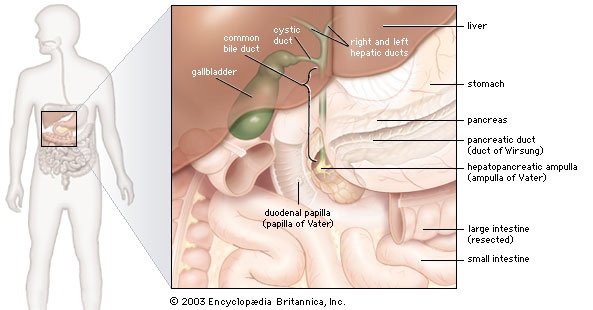gallbladder
anatomy
 a muscular membranous sac that stores and concentrates bile, a fluid that is received from the liver and is important in digestion. Situated beneath the liver, the gallbladder is pear-shaped and has a capacity of about 50 ml (1.7 fluid ounces). The inner surface of the gallbladder wall is lined with mucous-membrane tissue similar to that of the small intestine. Cells of the mucous membrane have hundreds of microscopic projections called microvilli, which increase the area of fluid absorption. The absorption of water and inorganic salts from the bile by the cells of the mucous membrane causes the stored bile to be about 5 times—but sometimes as much as 18 times—more concentrated than when it was produced in the liver.
a muscular membranous sac that stores and concentrates bile, a fluid that is received from the liver and is important in digestion. Situated beneath the liver, the gallbladder is pear-shaped and has a capacity of about 50 ml (1.7 fluid ounces). The inner surface of the gallbladder wall is lined with mucous-membrane tissue similar to that of the small intestine. Cells of the mucous membrane have hundreds of microscopic projections called microvilli, which increase the area of fluid absorption. The absorption of water and inorganic salts from the bile by the cells of the mucous membrane causes the stored bile to be about 5 times—but sometimes as much as 18 times—more concentrated than when it was produced in the liver.Contraction of the muscle wall in the gallbladder is stimulated by the vagus nerve of the parasympathetic system and by the hormone cholecystokinin (cholecystokinin/pancreozymin), which is produced in the upper portions of the intestine. The contractions result in the discharge of bile through the bile duct into the duodenum of the small intestine. The bile duct is composed of three branches, which are arranged into the shape of the letter Y. The lower segment is the common bile duct; it terminates in the duodenal wall of the small intestine. A constriction at the end of the common duct, called the sphincter of Oddi, regulates the flow of bile into the duodenum. The upper right branch is the hepatic duct, which leads to the liver, where bile is produced. The upper left branch, the cystic duct, passes to the gallbladder, where bile is stored.
Bile flows from the two lobes of the liver into the hepatic and common bile ducts. If food is present in the small intestine, the bile will continue directly into the duodenum. If the small intestine is empty, the sphincter of Oddi will be closed, and bile flowing down the common duct will accumulate and be forced back up the tube until it reaches the open cystic duct. The bile flows into the cystic duct and gallbladder, where it is stored and concentrated until needed. When food enters the duodenum, the common duct's sphincter opens, the gallbladder contracts, and bile enters the duodenum to aid in the digestion of fats.
The gallbladder is commonly subject to many disorders, particularly the formation of solid deposits called gallstones. Despite its activity, it can be surgically removed without serious effect.
- 1st Baron Collingwood, Cuthbert Collingwood
- 1st Baron Coventry, Thomas Coventry
- 1st Baron Cunliffe, Walter Cunliffe
- 1st Baron Dartmouth, George Legge
- 1st Baron Davies, David Davies
- 1st Baron Delamere, George Booth
- 1st Baron Dorchester, Guy Carleton
- 1st Baron Dowding, Hugh Caswall Tremenheere Dowding
- 1st Baron Erskine, Thomas Erskine
- 1st Baronet Arthur, Sir George
- 1st Baronet Ball, Sir Alexander John
- 1st Baronet Baring, Sir Francis
- 1st Baronet Beaumont, Sir John
- 1st Baronet Blane, Sir Gilbert
- 1st Baronet Bowman, Sir William
- 1st Baronet Brodie, Sir Benjamin Collins
- 1st Baronet Brunton, Sir Thomas Lauder
- 1st Baronet Brydges, Sir Samuel Egerton
- 1st Baronet Burne-Jones, Sir Edward Coley
- 1st Baronet Buxton, Sir Thomas Fowell
- 1st Baronet Cheyne, Sir William Watson
- 1st Baronet Child, Sir Josiah
- 1st Baronet Cooper, Sir Astley Paston
- 1st Baronet Cotton, Sir Robert Bruce
- 1st Baronet Cunard, Sir Samuel